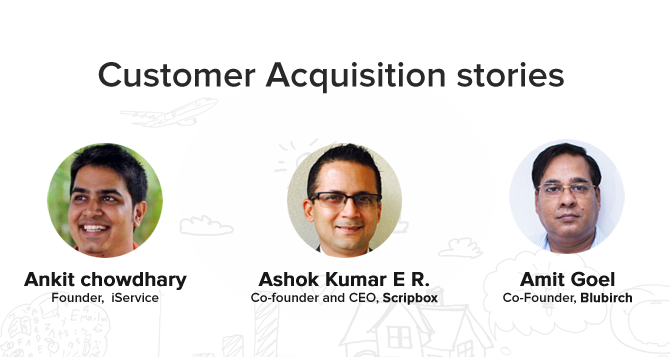“There is a story behind everything”, is something my boss (@Nilesh Patel) is fond of telling me. As a content marketer, I am trained to hunt out the interesting story that almost always gets missed behind regular life.
The story of your business, especially your customer acquisition strategy, is no different. Have you had a “Oh Crap” moment and rushed to modify it? Or have you had to constantly evolve your strategy to keep up with your business goals?
Whatever the story, we want to hear it – and that is why the “customer acquisition round table” was born. It is a place for entrepreneurs to come share their stories on customer acquisition – and swap learnings.
The Round Table Meet last Friday (8th July 2016) saw CXOs from three different business sharing their learnings, with a set of hand-picked audience. Ankit Chowdhary (Founder of iService), Ashok Kumar (Co-founder and CEO of Scripbox), and Amit Goel (Co-founder and Enterprise Sales Head of Blubirch) spoke at length about their entrepreneurial journey thus far.
(Want a more detailed log of what they spoke about? Read the customer acquisition stories of Ankit on Customer trust, of Ashok on Financial services marketing and Amit on B2B sales)

Here are the key take-aways
Though Ankit, Ashok and Amit spoke entirely about their businesses, I found that some learnings that they had gathered invariably overlapped. Ah, don’t worry – here is a brief round up of that.
Build trust
True to the spirit of the event, the speakers spoke about how building trust was a key feature to bringing in more customers. A happy customer brings in ten more and the word of mouth referral can do wonders for your brand. In fact, for Ankit (iService), about 50% of his customers come from word-of mouth referrals.
Train your people well
Interestingly, our speaker Amit (the only B2B entrepreneur among this time’s speakers) touched upon the importance of training the sales team well. Since the sales guys are in the forefront of customer acquisition, it is necessary that they have a clear idea about the business before they make their first pitch. In fact, when he asked his sales team what the company (Blubirch) was about, he actually got five different answers from the 5 people there.
That was when he decided to take up sales training seriously and ensured that every sales member knows exactly how and what to pitch. The result? An immediate spike in sales performance. Even Ashok admitted that his Scripbox team underwent a rigorous training for close to one month before they handled a call.
Speak the language of your prospects
Another aspect the founders touched upon is the relatability to the prospects. Unless the prospects easily understand what your business was about, they would be reluctant to convert. An excellent example here is Scripbox – who had to break down the complex world of Mutual fund investments into simple language that was easy enough for the layman to understand. Oh, they did it beautifully – you don’t get awarded the second most influential financial brand on Linkedin for nothing!
In short, it was a hugely successful event, with both the participants and speakers happy with the quality of discussion and learnings shared.
The next round table event is happening soon! Once I get that story, I shall tell you all about it.






